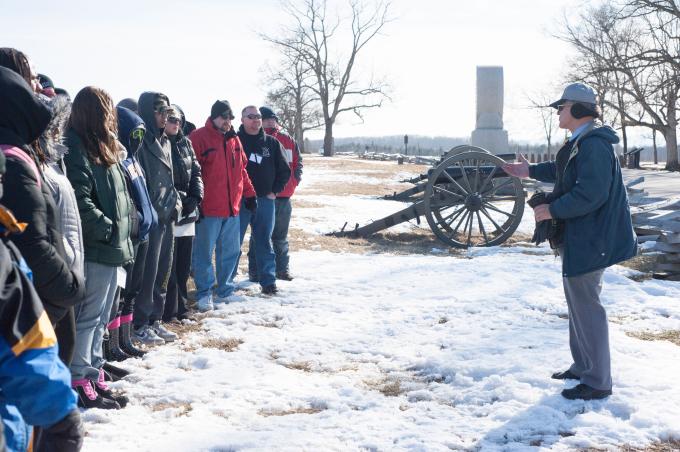Gettysburg Trip provides timeless lessons about business strategy
 The Point
The Point
Spring 2014
By George C. Bromall II, J.D., associate dean and professor, School of Business
Looking back at my education, there are plenty of things I've forgotten ... but I can remember in great detail every single field trip I ever took.
That's why each year in late January or early February, I take a group of "Business History Perspectives" students to the Gettysburg battlefield for a long three-day weekend to learn something about history, and a lot about business strategy.
We start on the bus trip across the state with rolling lectures and audio/visual presentations. But the real learning comes as we near the site and start seeing buildings still pockmarked with gunfire.
Gettysburg is the perfect place to teach about business strategy. Robert E. Lee and George Meade were military men, but they were also leaders of large organizations - CEOs in fierce competition with their rivals.
There are a number of business lessons to be found at the battlefield. Some of my favorites:
• Inventory - The armies that converged on Gettysburg brought with them 164,000 troops. Each soldier needed to be fed, clothed, and housed. They needed supplies and guns. They needed bullets. To succeed in business, you need the supplies and equipment to do the job.
• Leadership - Colonel Joshua Chamberlain, a college professor from Maine, defended Little Round Top with a group of scared soldiers, including a large contingent of deserters. They not only held the position, but, as ammunition began running out, charged down the hill with bayonets. Chamberlain's men followed him not because they had to but because they wanted to. Many a CEO today could learn from that lesson.
• Consequences - Nowhere more than a battlefield is the lesson clearer that executive decisions can have far-reaching consequences for those under your command. War is a testament to the responsibility leaders have to make wise decisions. Leaders usually walk away from bad decisions in fairly good shape; their subordinates often do not.
Related links
• Communications - Mistakes made at Gettysburg were because leaders didn't have all the information they needed at hand. Communication today is at the speed of light, but the message still fails to get through at times, with dire consequences.
• Flexibility - You can't have a business these days without a "strategic plan" to guide your actions. Both sides went into the conflict with their own strategic plans, but both found five minutes in that those plans had to be tossed out the window and new plans formulated on the spot.
Although the battle itself took place in July, I take my students in the off-season. Without all the foliage on the trees, they can see across the battlefield and visualize how, when, and where important leadership decisions were made. But visiting the site in the dead of winter also brings home that thousands of Americans lost their lives in just a few days of conflict.
Something our students will find hard to forget.
This article originally ran in the Pittsburgh Tribune Review on February 21, 2014. Reprinted with permission.
Photo and video by Chris Rolinson, associate professor of photojournalism.
The Point is a magazine for alumni and friends of Point Park University.

